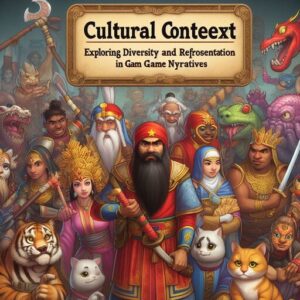
Narrative innovation in game storytelling involves pushing the boundaries of traditional storytelling techniques to create immersive and engaging experiences for players. By embracing new forms of narrative expression, game developers can deliver unique and memorable storytelling experiences that captivate and inspire players. In this article, we explore the concept of narrative innovation in game design and examine how developers are pushing the boundaries of game storytelling to create groundbreaking experiences.
The Evolution of Game Storytelling
Game storytelling has evolved significantly over the years, from simple text-based adventures to complex, narrative-driven experiences with branching paths, multiple endings, and interactive dialogue options. As technology has advanced, developers have explored new ways of telling stories in games, incorporating cinematic techniques, dynamic storytelling systems, and innovative narrative structures to create immersive and engaging player experiences. Narrative innovation continues to push the boundaries of game storytelling, offering exciting new possibilities for interactive storytelling in games.

Part 1: Interactive Narrative Experiences
Nonlinear Storytelling
Nonlinear storytelling involves presenting the narrative in a non-chronological or non-linear fashion, allowing players to explore different paths and outcomes based on their choices and actions. Developers design games with branching paths, multiple endings, and interactive dialogue options that give players agency over the narrative, creating opportunities for emergent storytelling moments and unexpected plot twists. By embracing nonlinear storytelling, developers create immersive and replayable narrative experiences that offer players a greater sense of agency and immersion in the game world.
Player-Driven Narratives
Player-driven narratives involve giving players control over the direction and outcome of the story, allowing them to shape their own unique storytelling experience. Developers design games with open-ended gameplay, dynamic narrative systems, and emergent storytelling mechanics that respond to player actions and decisions in real-time. By embracing player-driven narratives, developers create opportunities for players to become active participants in the storytelling process, fostering a deeper connection to the game world and its characters.
Part 2: Experimental Narrative Techniques
Environmental Storytelling
Environmental storytelling involves using the game world itself to convey narrative elements, such as lore, backstory, and thematic motifs. Developers design environments, architecture, and props that tell a story through visual cues, environmental details, and interactive elements. By immersing players in a richly detailed and immersive game world, developers create opportunities for players to uncover hidden stories and lore, enhancing their immersion and engagement in the narrative experience.
Transmedia Storytelling
Transmedia storytelling involves telling a single narrative across multiple platforms and media formats, such as games, books, comics, and films. Developers create interconnected narratives that unfold across different media, allowing players to explore the story from different perspectives and gain a deeper understanding of the game world and its characters. By embracing transmedia storytelling, developers create opportunities for players to engage with the narrative on multiple levels, enhancing their immersion and investment in the game world.
Part 3: Experimental Narrative Structures
Episodic Storytelling
Episodic storytelling involves releasing game content in a series of episodic installments, each with its own self-contained story arc and narrative progression. Developers design games with episodic structures that allow for ongoing storytelling, character development, and world-building over time. By embracing episodic storytelling, developers create opportunities for players to engage with the narrative over an extended period, fostering anticipation and excitement for each new installment.
Non-Linear Narrative Structures
Non-linear narrative structures involve presenting the story in a non-linear fashion, with multiple story threads, timelines, and perspectives that intersect and converge over the course of the game. Developers design narratives with complex branching paths, intertwining plotlines, and layered storytelling techniques that challenge players to piece together the puzzle of the narrative. By embracing non-linear narrative structures, developers create opportunities for players to explore the story from different angles and uncover hidden secrets and mysteries, enhancing their immersion and engagement in the game world.

